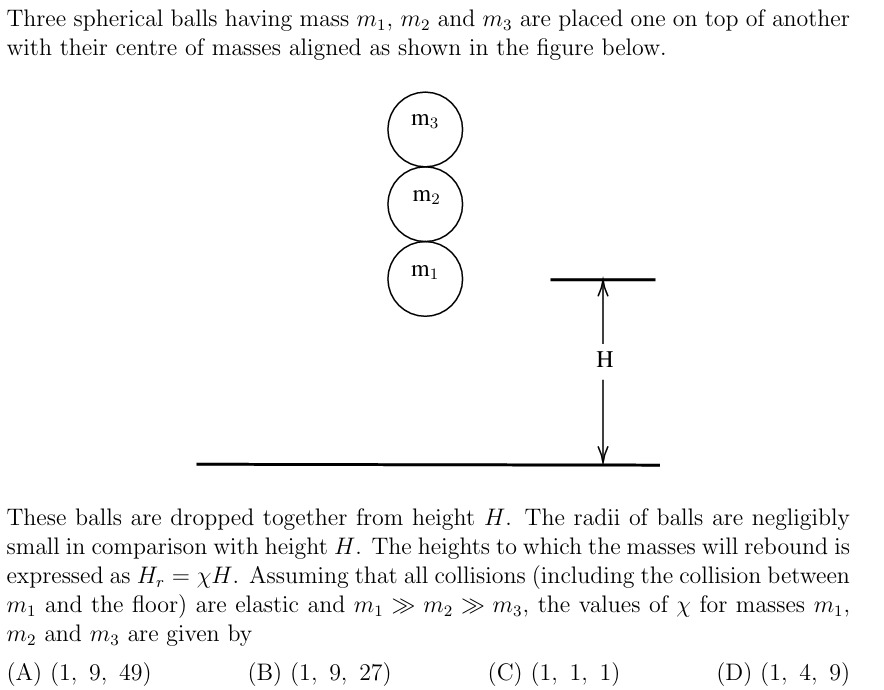Question
Question: Three spherical balls having mass $m_1$, $m_2$ and $m_3$ are placed one on top of another with their...
Three spherical balls having mass m1, m2 and m3 are placed one on top of another with their centre of masses aligned as shown in the figure below.
These balls are dropped together from height H. The radii of balls are negligibly small in comparison with height H. The heights to which the masses will rebound is expressed as Hr=χH. Assuming that all collisions (including the collision between m1 and the floor) are elastic and m1≫m2≫m3, the values of χ for masses m1, m2 and m3 are given by

(1, 9, 49)
(1, 9, 27)
(1, 1, 1)
(1, 4, 9)
(1, 9, 49)
Solution
The problem describes three spherical balls of masses m1, m2, and m3 stacked vertically and dropped from a height H. We are given that all collisions are elastic and that m1≫m2≫m3. We need to find the rebound heights for each mass, expressed as Hr=χH.
Let v0 be the speed of the balls just before the first collision with the floor. From conservation of energy, mgh=21mv2, so v0=2gH. All balls initially move downwards with this speed.
We will analyze the collisions sequentially, using the property of elastic collisions between a very massive object (M) and a very light object (m), where M≫m. If UM and Um are their initial velocities, and VM and Vm are their final velocities, then for an elastic collision (e=1):
- VM≈UM (the velocity of the massive object is almost unchanged).
- Vm≈2UM−Um (the velocity of the light object is approximately twice the velocity of the massive object minus its own initial velocity).
Step 1: Collision of m1 with the floor
The floor can be considered an infinitely massive object.
Initial velocity of floor, Ufloor=0.
Initial velocity of m1, Um1=−v0 (downwards).
After the elastic collision:
Vm1≈2Ufloor−Um1=2(0)−(−v0)=v0.
So, m1 rebounds upwards with a speed of v0.
Step 2: Collision of m2 with m1
At the moment of this collision, m1 is moving upwards with speed v0, and m2 is still moving downwards with speed v0 (since the radii are negligible, m2 hasn't hit m1 yet).
Here, m1 acts as the massive object (M) and m2 as the light object (m).
Initial velocity of m1, Um1′=v0 (upwards).
Initial velocity of m2, Um2=−v0 (downwards).
After the elastic collision:
Vm1′≈Um1′=v0. (Velocity of m1 after colliding with m2)
Vm2≈2Um1′−Um2=2(v0)−(−v0)=3v0. (Velocity of m2 after colliding with m1)
So, m2 rebounds upwards with a speed of 3v0.
Step 3: Collision of m3 with m2
At the moment of this collision, m2 is moving upwards with speed 3v0, and m3 is still moving downwards with speed v0.
Here, m2 acts as the massive object (M) and m3 as the light object (m).
Initial velocity of m2, Um2′=3v0 (upwards).
Initial velocity of m3, Um3=−v0 (downwards).
After the elastic collision:
Vm2′≈Um2′=3v0. (Velocity of m2 after colliding with m3)
Vm3≈2Um2′−Um3=2(3v0)−(−v0)=6v0+v0=7v0. (Velocity of m3 after colliding with m2)
So, m3 rebounds upwards with a speed of 7v0.
Rebound Heights:
The height to which a mass rebounds is given by Hr=2gVr2.
Since v0=2gH, we have v02=2gH. Therefore, H=2gv02.
For m1:
Rebound velocity Vr1=v0.
Hr1=2gVr12=2gv02=H.
So, χ1=1.
For m2:
Rebound velocity Vr2=3v0.
Hr2=2gVr22=2g(3v0)2=2g9v02=9H.
So, χ2=9.
For m3:
Rebound velocity Vr3=7v0.
Hr3=2gVr32=2g(7v0)2=2g49v02=49H.
So, χ3=49.
The values of χ for masses m1, m2, and m3 are (1, 9, 49).
